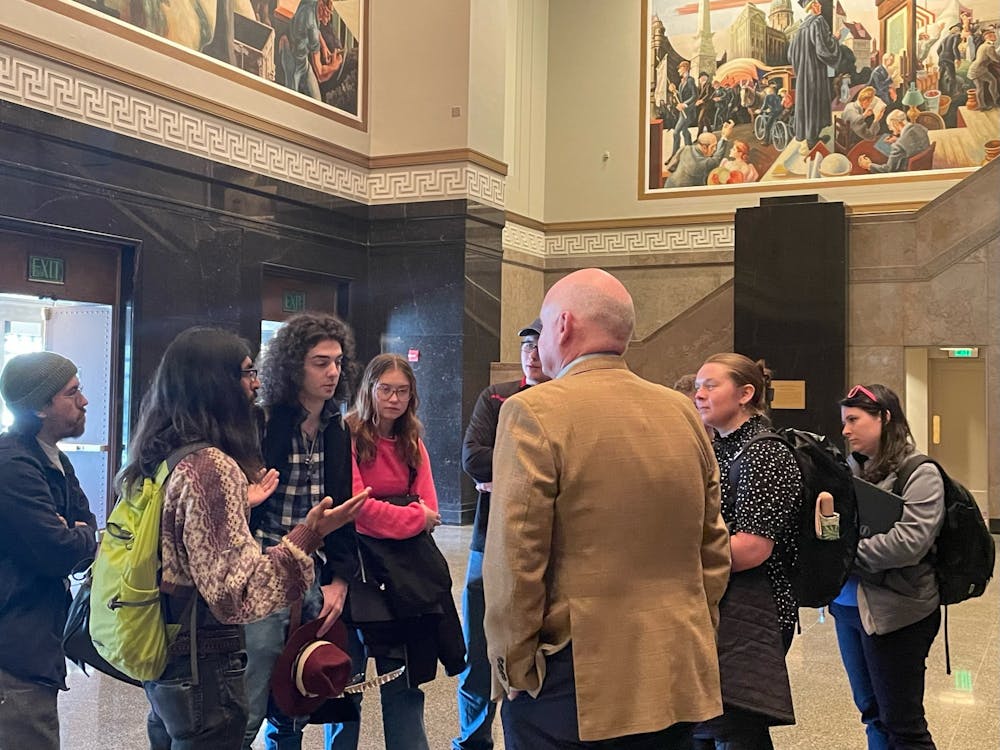Members of IU’s Climate Action Planning Committee hosted a forum at the IU Auditorium Thursday, detailing more information about their upcoming recommendations to reduce IU’s carbon footprint.
The committee was established in spring 2022 by IU President Pamela Whitten after multiple student protests, such as demonstrations by climate activism group Students for a New Green World. The committee consists of professors, staff and students from several IU campuses. No SNGW members are on the committee.
The committee was directed to create comprehensive recommendations to reduce IU’s greenhouse gas emissions, with the goal of carbon neutrality by 2040. The final recommendations will be sent to President Whitten no later than April 30.
Committee Chair Thomas Morrison introduced the committee, followed by a presentation by Jessica Davis, interim university director of sustainability and committee member. Davis said in the forum’s presentation their recommendations would be grouped into six categories: renewables, utility grid, behavior, infrastructure, financing and implementation.
Davis said the committee will propose expansions of renewable energy to supply IU’s energy, resulting in a 10.9% of the plan’s 100% reduction in emissions. Some examples include investments in solar panels and decarbonizing IU Bloomington’s central heating plant with either biogas or renewable energy options between the years 2038-2039.
“There are two main sources of renewable energy that could be feasible in this application,” Davis said. “One is hydrogen, and the other is nuclear.”
[Related: OPINION: What are we prepared to do to halt climate change?]
Davis highlighted the importance of collaborating with researchers and energy providers as technology continues to develop.
“There is going to be a lot of new technology on the market within the next decade,” she said. “There are things we may suggest today that in five years may not be the best recommendations.”
Davis said that collaboration with Indiana utility companies would be crucial for major reductions in emissions, accounting for an additional 44.7% reduction. Because many Indiana utility companies are on similar timelines of decarbonization as IU, Davis said through collaboration and adaptation to the progress of energy suppliers’ conversion to renewable energy, IU will be able to greatly reduce its carbon footprint.
Changing student and staff’s behavior will also be a key part of the committee’s recommendations, resulting in a 5% reduction in carbon emissions. Davis said specifics of this include encouraging the use of shared utilities, such as having students and staff use communal appliances in public areas rather than individual items like space heaters, refrigerators or printers.
Next, Davis said improving IU’s infrastructure would lead to another 39.4% reduction in emissions. Replacing old equipment with more energy-efficient EnergyStar-certified equipment, investments in electric vehicles and smarter solutions to heating through geothermal tapping and automation will reduce carbon output, she said.
Davis said the committee’s recommendations to fund these projects are to create a central energy fund, request money from the state and foster grant applications from federal or philanthropic sources.
As for implementation, Davis said creating a full-time sustainability staff on each campus is essential to making sure their plan will be executed properly. In addition, the committee will recommend regular meetings and community communication to ensure their reporting will be as transparent as possible if the plan is passed.
[Related: IU has committed to environmental sustainability- student activists say it’s not enough]
Davis also highlighted the committee’s incorporation of prior feedback about the plan given by student activists. As a result, the committee’s recommendations will no longer contain carbon or energy credits, a measure protested in prior forums.
The audience, largely composed of SNGW members, commented on the state of current recommendations after Davis’s presentation concluded.
SNGW President Sophie Hall asked about specific dates to accomplish emission-reduction goals and raised concerns about replacing IU Bloomington’s central heating plant just one or two years before the 2040 goal of carbon neutrality.
Davis said in response that specific dates will be in the document sent to President Whitten, and they are exploring multiple options for the heating plant.
Morrison said if financing data is available, specific dates will be presented at an online forum on April 18.
Former SNGW President Sidd Das raised concerns about President Whitten’s absence at the forum, especially due to her pivotal role in approving or disapproving the committee’s recommendations.
In response, Davis said that their strict following of President Whitten’s guidelines for the committee will hopefully ensure their recommendation's full passage.
“It’s sometimes penciling out to be a financial win, some things pay for themselves,” Davis said, referring to financing.
[Related: This year’s warm winter, explained]
The meeting ended, but members of the committee and SNGW continued to talk about the plan’s specific details in-depth among themselves in the auditorium lobby.
“Overall, my fingers are crossed,” Cooper Sykes, vice president of SNGW, said. “My biggest hope from this right now is that they continue to work on the dates and ensure it will actually pass.”
The committee took notes on all suggestions and said they will incorporate feedback into their final plan, which will be given to President Whitten by April 30. The committee will also host several more forums across IU’s campuses, including a final virtual forum at noon on April 18.





